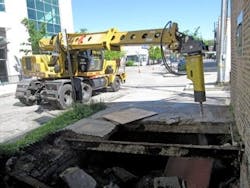City of Chicago tackles challenging vaulted sidewalks
The city of Chicago constantly faces the challenge of upgrading its aging infrastructure – sidewalks, roads and bridges as well as water and sewer lines that require either urgent repairs or routine replacement.
One of those tasks is replacing vaulted sidewalks, created many years ago to allow coal to be delivered into cellars in a large passageway under the concrete surface. In one north-side retail district, the challenge was to demolish and remove 5-in.-thick pieces of concrete that covered a vaulted sidewalk that ran about 10 ft from the curb to the outside wall of a restaurant. The length of the vaulted sidewalk was about 100 ft, creating a sizeable challenge.
“Under the sidewalk was an area about 4 ft deep,” said Andy Bazan from Finkbiner Equipment, who was monitoring work on the job as city employees used a Gradall XL 4100 IV excavator.
“This sidewalk was typical, with an opening from the building’s basement into the area underneath. Over the years, the area gets filled up with old equipment, chairs, debris and trash. As time goes by, and the sidewalk weakens and starts to deteriorate, litter, rocks, stones and other materials fall into the area.”
Kevin Kelly, a city employee who has been operating mostly Gradalls for more than 10 years, was operating the XL 4100 IV – first with a hydraulic hammer attachment to break up the concrete.
Using a tilting boom, he was able to precisely place the hammer’s tool, which was especially important working up close to store walls. The telescoping boom action also let him maneuver the hammer while avoiding overhead contract with signs and tree limbs.
Next, he changed to a pavement-removal bucket. “It takes me only two to five minutes to change attachments,” said Kelly. “It’s pretty simple if you’ve done it often enough.
The precise boom-tilting action and the ability to work in low-overhead locations helped him work more efficiently as he removed the pieces of demolished concrete and the debris from beneath the sidewalk.
Because of the tight working conditions, the excavator’s shorter rear swing was able to minimize impact on normal traffic flow. A dump truck would not fit close to the demolition site, so after the operator picked up pieces of concrete and debris, he drove the carrier from the upper-structure cab a short distance to the truck.
Once the concrete was broken up and removed, a crew formed up a new wall beneath the front wall of the building, and an excavating bucket was used to spread stone that was later compacted. The final step in the process involved pouring new concrete.
